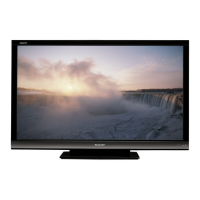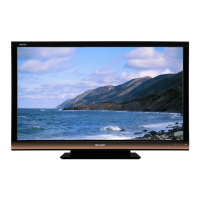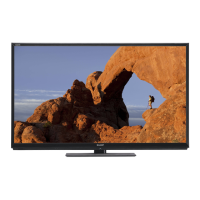LC-60/70EQ10U,SQ10U/15U/17U,TQ15U,UQ17U
5 – 13
9. White balance adjustment
9.1. White balance adjustment (For details about the adjustment procedure, refer to “Kameyama Model Integrated Monitor
WB Adjustment Specification V1.92”.)
• LC-60/70EQ10U/SQ10U,15U,17U/TQ15U
Adjustment
point
Adjustment conditions Adjustment procedure
1 Setting 1) Set the unit to the following conditions.
AV MODE: [DYNAMIC]
Backlight: +16
Active Backlight: OFF
Aging Time: Min. 60 minutes
2) Connect the unit with the white balance adjustment jig.
2 Automatic
adjustment exe-
cution
[Command]
Process mode
KRSW0001
KKT10037
Setting
KY0F0000
0SDS0001
SBSL0016
Multi-point adjustment mode
MSET0011
Point 7
LEV70232
MG7G****
MG7B****
MG7R****
MG7Y****
Point 6
LEV60196
MG6G****
MG6B****
MG6R****
MG6Y****
Point 5
LEV50156
MG5G****
MG5B****
MG5R****
MG5Y****
Point 4
LEV40108
MG4G****
MG4B****
MG4R****
MG4Y****
Point 3
LEV30076
MG3G****
MG3B****
MG3R****
MG3Y****
Point 2
LEV20048
MG2G****
MG2B****
MG2R****
MG2Y****
Writing
MSET0003
[Adjustment procedure]
1) Send the “adjustment process” code using the remote control.
2) Set the point 7 to the specified gradation, specify the strongest color as the fixed
color, and adjust the RGB so that it becomes the standard value through the negative
adjustment.
After adjustment, compare the R and G values; based on that result, calculate the Ye
value in the following conditions.
R > G: Ye = G x 1.05
R ≤ G: Ye = R x 1.05
* If the Ye value exceeds the initial value (input gradation x 4), round it off to that
value or less.
[WBstep2 readjustment]
Measure the brightness YWB7 after adjusting the above point 7.
(i) If YWB7 ≥ Yth [cd/m2], go to step 3.
(ii) If YWB7 < Yth [cd/m2]:
a) If R adjustment value (R7) of point 7 ≠ R initial value of point 7, go to step 3.
b) If R adjustment value (R7) of point 7 = R initial value of point 7:
GAIN = (Ybr/YWB7)1/2 (If GAIN > [G gain limit], set as GAIN = [G gain limit].)
G7’ = GAIN x G7 (If G7’ > 928, set as G7’ = 928.)
Y7’ = G7’ x 1.05 (If Y7’ > 928, set as Y7’ = 928.)
B7’ = B7 x (G7’/G7) (If B7’ > 928, set as B7’ = 928.)
Change the adjustment values of G, B, and Y to G7’, B7’, and Y7’, and then go to step
3.
Threshold and correction upper limit value
Yth = 199 [cd/m2], Ybr = 204 [cd/m2],
G gain limit = 1.10 [times]
3) Set the point 6 to the specified gradation, and set the G correction value (784 x G
value of point 7/928) (fractions rounded off) and the Ye correction value (784 x Ye
value of point 7/928) (fractions rounded off); then adjust RB so that it becomes the
standard value.
4) Set the point 5 to the specified gradation, and set the G correction value (624 x G
value of point 7/928) (fractions rounded off) and the Ye correction value (624 x Ye
value of point 7/928) (fractions rounded off); then adjust RB so that it becomes the
standard value.
5) Set the point 4 to the specified gradation, and set the G correction value (432 x G
value of point 7/928) (fractions rounded off) and the Ye correction value (432 x Ye
value of point 7/928) (fractions rounded off); then adjust RB so that it becomes the
standard value.
6) Set the point 3 to the specified gradation, and set the G correction value (304 x G
value of point 7/928) (fractions rounded off) and the Ye correction value (304 x Ye
value of point 7/928) (fractions rounded off); then adjust RB so that it becomes the
standard value.
7) Set the point 2 to the specified gradation, and set the G correction value (192 x G
value of point 7/928) (fractions rounded off) and the Ye correction value (192 x Ye
value of point 7/928) (fractions rounded off); then adjust RB so that it becomes the
standard value.
8) Set the point 1 to the specified gradation, and set as follows:
G correction value (80 x G value of point 7/928) (fractions rounded off)
Ye correction value (80 x Ye value of point 7/928) (fractions rounded off)
R correction value (80 x R value of point 2/180) x R_GAIN (fractions rounded off)
B correction value (80 x B value of point 2/180) x B_GAIN (fractions rounded off)
GAIN value
R_GAIN = 0.981, B_GAIN = 1.149
9) Write the adjustment value by the MSET0003 command.
*
R
GBY initial value of point 7: Set gradation 928
[Adjustment value]
* According to the “Standard settings” submitted by the Technical Department
[LC60SQ15U] SQ17U,15U,10U/EQ10U/TQ15U teaching set

